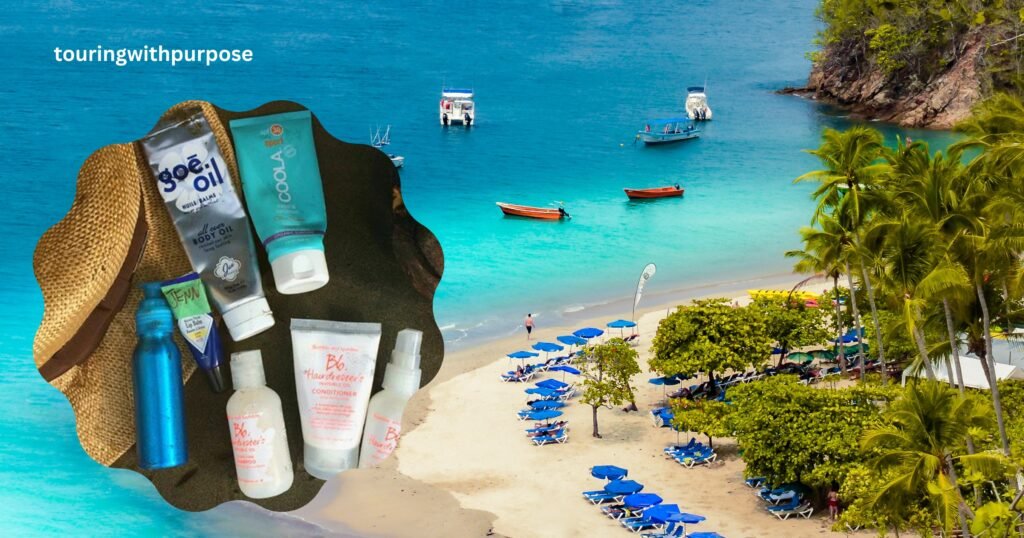Costa Rica is a rugged, rainforested Central American country with coastlines on the Caribbean and Pacific.
Though its capital, San Jose, is home to cultural institutions like the Pre-Columbian Gold Museum, Costa Rica is known for its beaches, volcanoes, and biodiversity.
Roughly a quarter of its area comprises a protected jungle teeming with wildlife, including spider monkeys and quetzal birds.
These are the essential items for your Costa Rica packing list: lightweight, dry, fast clothes, comfortable sandals, swimwear, mosquito repellent, sunscreen SPF 30+, hiking shoes/trail running shoes or closed-toed hiking sandals, sunglasses, a hat, battery pack, medical kit, waterproof phone case, camera, day pack, rain …
Traveling to Costa Rica offers the opportunity to explore its diverse landscapes, from lush rainforests to beautiful beaches.
Packaging wisely is essential to make the most of your trip. Here’s a detailed list of what to bring to Costa Rica, along with some travel tips:
Complete Packing: Costa Rica Travel Tips What To Bring

Travel Documents
- Passport (valid for at least six months beyond your travel dates).
- Photocopies of your passport, driver’s license, and other essential documents.
- Travel itinerary, including flight details, hotel reservations, and contact information.
Visa and Entry Requirements
- Check the visa requirements for your nationality and ensure you have the necessary visas if required.
Money and Payment
- U.S. dollars (small denominations) for emergencies and local currency, Costa Rican colón (CRC), for everyday expenses.
- Credit/debit cards for larger purchases (notify your bank of travel plans).
- Travel insurance information and policy documents.
Health and Safety
- Necessary medications, along with prescriptions and a list of generic names.
- The first-aid kit includes bandages, antiseptic wipes, pain relievers, and personal medications.
- Insect repellent with DEET for protection against mosquitoes.
- Sunscreen with high SPF, sunglasses, and a wide-brimmed hat for sun protection.
- Travel insurance, including coverage for medical emergencies.
Clothing and Footwear
- Lightweight, breathable clothing suitable for warm weather.
- Bathing suits for beach visits and water activities.
- Rain jacket or poncho for sudden tropical showers.
- Comfortable walking shoes or hiking boots if you plan to explore rainforests or hike.
- Sandals or flip-flops for beach and casual wear.
- Light long-sleeved shirts and pants for protection against bugs and the sun.
- A lightweight sweater or jacket for cooler evenings in higher-altitude areas.
Electronics and Accessories
- Universal power adapter (Costa Rica uses Type A and Type B sockets).
- Power bank for charging devices on the go.
- Smartphones with essential travel apps, such as maps and translation tools.
- Waterproof bag or case for protecting your electronics near water.
Travel Gear
- Daypack for excursions and beach outings.
- Travel towel or sarong for the beach.
- Reusable water bottles to stay hydrated (Costa Rica has safe tap water in most places).
- Travel locks to secure your belongings.
- Zip-top bags for keeping documents and electronics dry.
Guidebooks and Maps
- Guidebook or travel apps to help plan your activities and navigate the country.
- Maps of the areas you plan to visit.
Spanish Phrases
- A basic Spanish phrasebook or language app to help with communication.
Miscellaneous
- Snorkeling gear if you plan to explore coral reefs.
- Travel-sized toiletries, including shampoo, soap, and toothpaste.
- Hand sanitizer and wet wipes for hygiene.
- Camera or smartphone for capturing memories.
Packing Tips
- Pack light and prioritize versatile clothing that you can mix and match.
- Roll clothes to save space and minimize wrinkles.
- Use packing cubes or compression bags to organize and maximize suitcase space.
- Keep important documents and valuables in a waterproof pouch or hidden pocket.
Best Shoes For Men And Women During Costa Rica Trip
Here are recommendations for the best shoes for men and women for various types of Costa Rica trips:

For General Travel and Sightseeing
Men
- Comfortable walking shoes or sneakers with good arch support. Consider waterproof or water-resistant options for rainy days.
Women
- Athletic walking shoes or comfortable sneakers. Opt for shoes with breathable materials, as it can get quite warm.
For Beach Activities
- Men and Women: Water shoes or amphibious sandals with a sturdy sole are ideal for beach activities. They protect your feet from sharp rocks, coral, and sea creatures while providing good traction.
For Hiking and Outdoor Adventures
Men
- Hiking boots or trail shoes with good grip and ankle support. Waterproof options are advisable for hiking in wet or muddy areas.
Women
- Hiking boots or trail shoes designed for women with good arch support and tread for traction. Look for options that offer ankle support and are waterproof.
For Urban and Casual Dining
Men
- Comfortable and stylish closed-toe shoes or casual leather sneakers can work well for evenings in urban areas.
Women
- Casual flats, sandals, or comfortable closed-toe shoes that can transition from day to evening.

Best Clothing For Men and Women
When selecting the best clothing for men and women in Costa Rica, it’s essential to consider the country’s tropical climate and the diverse range of activities you may engage in. Here are clothing recommendations for both men and women:
For Men
- Lightweight T-Shirts
- Shorts
- Swim Trunks
- Lightweight Long Pants
- Sun Protection
- Hiking or Walking Shoes
- Sandals or Flip-Flops
- Rain Jacket or Poncho
- Lightweight Sweater or Jacket
- Insect Repellent
For Women
- Sundresses and Lightweight Dresses
- Shorts and Skirts
- Swimsuits
- Lightweight Tops
- Cover-ups
- Long Pants and Leggings
- Sun Protection
- Comfortable Walking Shoes
- Hiking Shoes
- Rain Jacket or Poncho
- Insect Repellent
Packing List Pieces of Advice For the Rainy Season
Here’s a packing list with advice for the rainy season:
Clothing
- Lightweight Rain Jacket
- Quick-Drying Pants
- Rainproof Footwear
- Umbrella
- Lightweight Long-Sleeved Shirts and Pants
- Quick-Drying Socks
- Swimwear
Accessories
- Waterproof Backpack or Dry Bag
- Ziplock Bags
- Toiletries
- Insect Repellent
- Miscellaneous
- Travel Towel
- Travel Laundry Kit
Optional Items
- Gaiters
- Rain Cover for Backpack

Cosmetics
When packing cosmetics for your trip to Costa Rica, it’s essential to consider the tropical climate, the activities you’ll be doing, and the potential for sunny and humid conditions. Here’s a list of essential cosmetics and some tips for your trip:
- Sunscreen
- Bug Repellent
- Moisturizer
- Makeup
- Cleanser
- Facial Wipes
- Body Wash
- Toothbrush and Toothpaste
- Hair Care
- Razor and Shaving Cream
- Deodorant
- Nail Care
- Contact Lenses and Solution
- Medications
Conclusion
In conclusion, when embarking on a journey to the beautiful landscapes and vibrant culture of Costa Rica, it is essential to heed the advice offered in the article “Costa Rica Travel Tips What To Bring.” By packing wisely and preparing adequately, travelers can ensure a smoother and more enjoyable experience in this remarkable destination. From appropriate clothing for varying climates to essential documents and insect repellent, these tips provide valuable insights into what to bring to make the most of your Costa Rican adventure. So, remember, your packing list can significantly influence the quality of your trip, and following the guidance in “Costa Rica Travel Tips What To Bring” will undoubtedly contribute to a memorable and hassle-free visit to this tropical paradise.
FAQs
Is Costa Rica Safe for Tourists?
Costa Rica is generally considered safe for tourists.
Like any country, it’s essential to exercise common-sense precautions, such as safeguarding your belongings and avoiding isolated areas at night.
What is the Best Time to Visit Costa Rica?
From December to April, the dry season is often considered the best time to visit Costa Rica, with pleasant weather and fewer rain showers.
However, the green (rainy) season, from May to November, offers lush landscapes and fewer crowds.
Do I Need a Visa to Visit Costa Rica?
The need for a visa depends on your nationality and the purpose and duration of your visit.
Many tourists can enter Costa Rica visa-free for up to 90 days, but it’s essential to check the specific requirements for your country before traveling.
What Vaccines Do I Need for Costa Rica?
While no specific vaccines are required for entry, it’s advisable to be up-to-date on routine vaccines like measles, mumps, rubella, and diphtheria-tetanus-pertussis. Depending on the areas you plan to visit, consult a healthcare provider about vaccinations for diseases like yellow fever and hepatitis A.
Is the Tap Water Safe to Drink in Costa Rica?
In most urban areas and tourist destinations, tap water is considered safe to drink. However, sticking to bottled or purified water in more remote areas is advisable to avoid potential stomach issues.
What Currency is Used in Costa Rica, and Can I Use U.S. Dollars?
The official currency of Costa Rica is the Costa Rican colón (CRC). While you can use U.S. dollars for some transactions, it’s recommended to have local currency on hand for smaller purchases and in more rural areas.
Most major credit cards are widely accepted in tourist areas.

